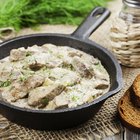
Spaghetti's a convenient meal for any cook with time constraints. It's simple to boil the pasta and heat a sauce, and cooking a large quantity doesn't take much longer than cooking a portion or two. Those qualities make it a good option when you're cooking for leftovers. Leftover spaghetti can provide a few days' quick meals, or you can freeze it for longer storage.
Refrigerator Storage Life
With leftovers, their shelf life is limited by the twin constraints of food safety and food quality. It's perfectly possible for your spaghetti or sauce to taste okay but still harbor dangerous levels of bacteria, or to be food safe but not taste as good as it should. In general, the USDA's guidelines recommend eating your leftovers within three to four days, which provides a good margin of error for both quality and safety. If you have more leftover sauce or spaghetti than you can use up within that time, you should freeze it to extend its shelf life.
Freezing Your Leftovers
Freezing your leftover spaghetti extends its lifespan to three to four months, ample time to use it up for quick and convenient meals. It will remain edible past that date, but its quality begins to decline. Your spaghetti tastes best if it's packaged with as little air as possible, so use a vacuum sealer if possible. If you don't have one, package the pasta in bags and squeeze out as much air as possible. Keep the pasta in single portions, so you can thaw only as much as you need. You can freeze your spaghetti in its sauce for quick microwave meals or separately for sit-down dinners.
Getting It Right
Keeping your leftovers safe depends largely on how quickly you refrigerate them after your meal. Package up your leftover spaghetti and sauce as soon as they're cooled, and get them into the fridge within two hours. If you have lots, divide them into small packages so they'll cool more quickly. Spread the containers around your fridge rather than stacking them, if you can, because the middle of each stack will retain heat. If you have to stack your containers because of space constraints, rotate them every hour or two so they cool evenly. Once they're cool, label and date them so you know which foods to use up first.
Enjoying Your Leftovers
Your leftovers have to be reheated to a minimum temperature of 165 degrees Fahrenheit to be food safe, but that's easy with pasta. Simmer your sauce in a saucepan, and dunk your spaghetti in a pot of boiling water. It only needs 30 seconds at a boil to be fully heated and food safe. Drain it and serve it with the sauce as you normally would. If you're reheating a portion of spaghetti and sauce in the microwave, stir it frequently and let it rest for at least two minutes so the heat can equalize throughout the dish. To be absolutely safe, test the meal with an instant-read thermometer to verify that it's at least 165 F.
Related Articles

How Long Can Chinese Food Sit Out ...

Number of Times Food Can Be Reheated

How Long & What Temperature Do You Bake ...

Can You Cook Beef Stroganoff Ahead of ...
Can You Refreeze BBQ or Spaghetti Sauce ...

How to Freeze Spinach

What Is the Fastest Way I Can Defrost ...

How to Freeze Lasagna After Baking It

Proper Ways to Cool Food After Cooking

Can You Make Chicken Fettuccine Alfredo ...

How to Freeze Sausage Biscuits
How to Keep Buffet Food Cool
How to Thaw, Cook & Refreeze Vegetables

Can You Freeze Homemade Calzones?

How Long Can Cooked Salmon Last ...

Can You Boil Water & Cook Spaghetti in ...

How Long to Cool a Quiche

How Long Is Cooked Chicken Good?

How to Freeze Figs

How to Heat Lasagna From the Fridge
References
Resources
Writer Bio
Fred Decker is a trained chef and prolific freelance writer. In previous careers, he sold insurance and mutual funds, and was a longtime retailer. He was educated at Memorial University of Newfoundland and the Northern Alberta Institute of Technology. His articles have appeared on numerous home and garden sites including GoneOutdoors, TheNest and eHow.
Photo Credits
Photos.com/Photos.com/Getty Images